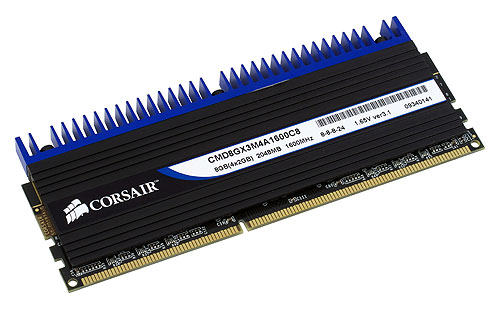LGA1156 Platform and DDR3-1600 Memory
|
Late in October, we tried to find out whether LGA1156 processors really needed high-frequency memory. It turned out that there was no need in chasing it -- a computer with DDR3-1066 memory was outperformed by that with DDR3-1333 by less than 1%. Hence the conclusion: as modern memory speed has grown significantly, the nominal mode does not need the fastest modifications. Even DDR3-1333 is already too much. Of course, faster memory will not deteriorate performance, but it makes no sense overpaying for it. On the other hand, memory prices are quite low these days. 4 GB of DDR3-1600 CL8 are just $30 more expensive than DDR3-1333 CL9. This is not much compared to the overall computer costs (even if you install 8 GB). Besides, all characteristics are much better, so users are tempted to pay a little more. Well, the best way to fight temptation is to be carried away by it. At least to get moral satisfaction.
The question is, what will you do with it afterwards? In fact, you can use such memory in two ways: either at 1600 MHz with nominal timings, or reduce the frequency and decrease relative timings. It's difficult to say which option is more interesting. Moreover, those of you who have Core i7 (not Core i5) may get the 1600 MHz clock rate in two ways: either by sticking to the nominal frequency and setting the memory multiplier to 12, or by raising the reference clock and reducing the multiplier. There will be a side effect -- overclocked L3 Cache (and memory controller). The UnCore multiplier is fixed in all LGA1156 processors. This should also affect performance, and the tests will show us how exactly. Today we have four configurations to review which are described in the table below.
| Testbed configurations |
2800, TB On, 1333-CL9 |
2800, TB Off, 1333-CL7 |
2800, TB Off, 1600-CL8 |
2720, TB Off, 1600-CL8 |
| Reference clock, MHz |
133 |
133 |
133 |
160 |
| Multiplier |
21-26 |
21 |
21 |
17 |
| Core clock, GHz |
2.8-3.47 |
2.8 |
2.8 |
2.72 |
| UnCore clock, GHz |
2.4 |
2.4 |
2.4 |
2.88 |
| Memory multiplier |
10 |
10 |
12 |
10 |
| Memory frequency, MHz |
1333 |
1333 |
1600 |
1600 |
| Relative timings |
9-9-9-24 |
7-7-7-20 |
8-8-8-24 |
8-8-8-24 |
We have chosen these parameters for a reason. First of all, as we plan to increase the reference clock, it makes sense to disable Turbo Boost. Besides, we'd better reduce the CPU multiplier, or we'll get performance gains due to its overclocking. The ideal modes for comparison would have been 133x12 and 200x8 (even CPU frequency can be set to the same value in this case). However, this reference clock is not always attainable for Core i7 800 because of the locked UnCore multiplier (especially on an inexpensive motherboard, like our Intel DP55WG), as cache memory frequency in this case should reach 3.6 GHz (very high). We tried it and failed. So a processor in the last configuration will be operating at a bit lower clock rate -- alas, this platform lacks fractional multipliers. In return, we have a significantly increased frequency of cache memory -- almost 500 MHz (it's more than in top Xeons and Core i7 Extreme). So let's see whether it can make up for the 80 MHz lag in the CPU clock rate (and how much). Another two configurations do not need any comments -- they differ only by a multiplier and latencies. Note that 1600-CL8 is better than 1333-CL7 both in memory bandwidth and latencies. We are tired of repeating that lower relative timings do not necessarily mean lower absolute latencies (it's the latter that affect performance), but we have to do it over and over again. The former is taken from the previous article for two reasons. For one, up to now we've been analyzing only the "boring" implementation of Turbo Boost in Core i7 900, so it will be interesting to evaluate performance gains from the improved version. For two, we'll see right away whether it's worth toying with memory. It goes without saying that both comparisons are not very well posed as far as methodology is concerned, but in this case we'll be satisfied with a rough qualitative (versus precise quantitative) answer.


We got the best of 8 GB memory kits from Corsair, namely CMD8GX3M4A1600C8, which can work at 1600 MHz with 8-8-8-24 timings (at the normal voltage level of 1.65 V), equipped with additional fans for better cooling.
I'd like to mention that the manufacturer has even faster memory kits for this platform, but they consist of only two memory modules with the total size of 4 GB. As a result, we think that they will be a good choice only for hardcore overclockers or benchers: larger memory volumes make more sense for serious applications in 64-bit operating systems. However, our tests also perform well with 4 GB (moreover, we test processors in this very configuration.) But in our opinion, it's better to have lots of fast memory than very fast memory, but little. Besides, if performance gains from fast memory are low, it makes no sense to buy very fast memory (unless you want to squeeze ultimate results from benchmarks).
Write a comment below. No registration needed!
|
|
 |
|
|
|



